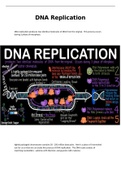Marocsofiane
On this page, you find all documents, package deals, and flashcards offered by seller marocsofiane.
- 26
- 0
- 0
Community
- Followers
- Following
26 items

Meiosis for healthcare students
Meiosis is cell division in the gonads (the ovaries or testes) that results in genetically unique gametes (eggs or sperm) containing only ONE copy of each gene.
- Interview
- • 4 pages •
Meiosis is cell division in the gonads (the ovaries or testes) that results in genetically unique gametes (eggs or sperm) containing only ONE copy of each gene.

Elements in the Human Body Notes
Carbon, hydrogen, oxygen, and nitrogen (CHON) are the most common elements in life forms. Carbon in particular is amazing in that it loves to form four bonds with other atoms. It and hydrogen are found
- Interview
- • 3 pages •
Carbon, hydrogen, oxygen, and nitrogen (CHON) are the most common elements in life forms. Carbon in particular is amazing in that it loves to form four bonds with other atoms. It and hydrogen are found

Elements in the human body for health students Notes (General Biology )
General Biology: Elements in the human body for health students Notes
- Interview
- • 2 pages •
General Biology: Elements in the human body for health students Notes

DNA Structure Notes
Nucleic acids are one of the four kinds of “biomolecules”. The other three are lipids, proteins, and carbohydrates. Each DNA strand contains the genetic information of one chromosome. Each chromosome contains 50 - 250 million nucleotide pairs.
- Interview
- • 4 pages •
Nucleic acids are one of the four kinds of “biomolecules”. The other three are lipids, proteins, and carbohydrates. Each DNA strand contains the genetic information of one chromosome. Each chromosome contains 50 - 250 million nucleotide pairs.

Carbohydrates as Biomolecules ( medical professional notes )
Carbohydrates are biomolecules that always contain carbon, hydrogen, and oxygen. Polysaccharides are built from monosaccharides
- Class notes
- • 5 pages •
Carbohydrates are biomolecules that always contain carbon, hydrogen, and oxygen. Polysaccharides are built from monosaccharides

DNA Structure for health students Notes (General Biology )
Nucleic acids are one of the four kinds of “biomolecules” (because they are found in living things). The other three are lipids, proteins, and carbohydrates. You may also see them referred to as “organic molecules” (because they are based on carbon structures), or “macromolecules” (because they are so huge)
- Interview
- • 2 pages •
Nucleic acids are one of the four kinds of “biomolecules” (because they are found in living things). The other three are lipids, proteins, and carbohydrates. You may also see them referred to as “organic molecules” (because they are based on carbon structures), or “macromolecules” (because they are so huge)

DNA Replication Notes
DNA replication produces two identical molecules of DNA from the original. This process occurs during S phase of interphase.
- Interview
- • 4 pages •
DNA replication produces two identical molecules of DNA from the original. This process occurs during S phase of interphase.

DNA Replication Notes For Health Students
DNA Replication Notes For Health Students
- Interview
- • 3 pages •
DNA Replication Notes For Health Students

Cellular Respiration Summary Notes
Cellular Respiration Summary Notes
- Interview
- • 1 pages •
Cellular Respiration Summary Notes

Cell Membrane Structure Notes
Membrane lipids have: Polar/hydrophilic heads and nonpolar/hydrophobic fatty acid tails
- Class notes
- • 4 pages •
Membrane lipids have: Polar/hydrophilic heads and nonpolar/hydrophobic fatty acid tails
